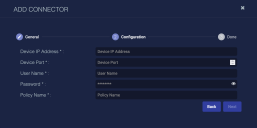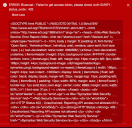Configuring F5 BIG-IP ASM Connectors
You can connect Stellar Cyber to firewalls so that you can quickly and easily implement firewall rules on those firewalls from within Stellar Cyber, while you are threat hunting. You can configure firewall actions or manually trigger a firewall action from the event display. For either action you must already have your firewall connected.
Connector Overview: F5 BIG-IP ASM
Capabilities
-
Collect: No
-
Respond: Yes
-
Native Alerts Mapped: No
-
Runs on: DP or Sensor
-
Interval: N/A
Collected Data
N/A
Domain
|
https://<Device IP Address>:<Device Port> where <Device IP Address> and <Device Port> are variables from the configuration of this connector |
Response Actions
|
Action |
Required Fields |
|---|---|
|
|
Third Party Native Alert Integration Details
N/A
Required Credentials
-
Device IP Address, Device Port, User Name, Password, and Policy Name
Let us know if you find the above overview useful.
Adding an F5 BIG-IP ASM Connector
To add a new F5 BIG-IP ASM firewall connector:
Creating a Policy
On your F5 BIG-IP ASM firewall:
-
Create a policy by navigating to Security | Application Security | Security policies.
-
Bind the policy to the application by navigating to Local Traffic | Virtual Servers | Virtual Server List | <server name> | Security | policies.
To view the IP addresses added to the policy, navigate to Security | Application Security | IP Addresses | IP Address Exceptions.
Adding the Connector in Stellar Cyber
To add a new F5 BIG-IP ASM firewall connector in Stellar Cyber:
-
Log in to Stellar Cyber.
-
Click System | Integration | Connectors. The Connector Overview appears.
-
Click Create. The General tab of the Add Connector screen appears. The information on this tab cannot be changed after you add the connector.
The asterisk (*) indicates a required field.
-
Choose Firewall from the Category drop-down.
-
Choose F5 BIG-IP ASM from the Type drop-down.
-
For this connector, the supported Function is Respond, which is enabled already.
-
Enter a Name.
This field does not accept multibyte characters.
-
Choose a Tenant Name. The Interflow records created by this connector include this tenant name.
-
Choose the device on which to run the connector.
-
Click Next. The Configuration tab appears.
The asterisk (*) indicates a required field.
-
Enter the Device IP Address. This is the management IP address for the firewall.
-
Enter the Device Port. This is the API port.
-
Enter the User Name to log in to the firewall.
-
Enter the Password to log in to the firewall.
The password should not include non-ASCII special characters.
-
Enter the Policy Name. This is the name of the policy to which the blocked IP is associated.
-
Click Next. The final confirmation tab appears.
-
Click Submit.
The new firewall connector is immediately active.
Testing the Connector
When you add (or edit) a connector, we recommend that you run a test to validate the connectivity parameters you entered. (The test validates only the authentication / connectivity; it does not validate data flow).
For connectors running on a sensor, Stellar Cyber recommends that you allow 30-60 seconds for new or modified configuration details to be propagated to the sensor before performing a test.
-
Click System | Integrations | Connectors. The Connector Overview appears.
-
Locate the connector that you added, or modified, or that you want to test.
-
Click Test at the right side of that row. The test runs immediately.
Note that you may run only one test at a time.
Stellar Cyber conducts a basic connectivity test for the connector and reports a success or failure result. A successful test indicates that you entered all of the connector information correctly.
To aid troubleshooting your connector, the dialog remains open until you explicitly close it by using the X button. If the test fails, you can select the button from the same row to review and correct issues.
The connector status is updated every five (5) minutes. A successful test clears the connector status, but if issues persist, the status reverts to failed after a minute.
Repeat the test as needed.








